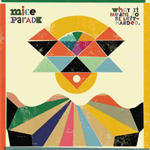|
|
 |
Dusted Reviews
Artist: Mice Parade Album: What It Means to Be Left-Handed Label: FatCat Review date: Sep. 16, 2010 |

|
|
|
 |
What It Means to Be Left-Handed shouldn’t be a difficult album to review. Fundamentally, it’s a straightforward pop record: it abounds in moments of verse/chorus/verse and loud/quiet/loud, and bandleader Adam Pierce has an easygoing, instantly familiar vocal style. There are no bursts of dissonance or experiments in welding avant-garde structures to pop sensibilities. It’s an enjoyable record to listen to — Pierce’s songwriting is rooted in a classic mid-’90s indie-rock sensibility, and when that comes to the forefront (as on “Mallo Cup”), he taps into a potent vein of post-Sebadoh melancholy.
Pierce’s ambitions are broader than that, however — and that’s one of the reasons that this album (and, arguably, the Mice Parade discography as a whole) isn’t so easy to classify. Past players on Mice Parade albums have included members of Múm; here, the lineup includes the Senegalese kora player Abdou M’Boup, the soul/jazz vocalist Somi, and longtime drummer Doug Scharin. That these guests hail from such a wide variety of musical backgrounds is a credit to Pierce’s stylistic range as a songwriter, but this range has drawbacks as well. What It Means to Be Left-Handed is less one coherent longform document and more a collection of singles — all of which should probably prompt some sort of rumination on the album as art form, and what that means in the midst of what may or may not be a digital-format-led single-song revival. But those debates can be read about elsewhere. And fundamentally, in reviewing this record, one has to assume that, if nothing else, Pierce does view this as a single work as opposed to a collection of several smaller works. But that logic isn’t always apparent to the listener; Left-Handed often feels like you’re tuned into to a particularly good freeform radio station.
There’s a sense of an increasingly globe-spanning sensibility on Pierce’s part, whether it’s M’Boup’s kora anchoring the opener “Kupanda” or the Scandinavian shoegaze of “In Between Times.” The more guitar-centric “Mallo Cup,” “Recover,” and “Couches and Carpets” have a greater similarity, and in their relative simplicity manage an even greater resonance. Another thread that manifests itself here is one with a more pronounced ambient/drone influence, heard most strongly on “Pond” and the drifting sound collage at the heart of “Tokyo Late Night.”
For all of the debate about its structure, one shouldn’t get the wrong idea. The 13 songs on What It Means to Be Left-Handed are all, in their own way, enjoyable. the ideas and collaborations on display are impressive, as is the stylistic range. But there’s still a bit of cohesion missing there — something that makes What It Means to Be Left-Handed feel more like a collection of individually good ideas and less like a singular artistic statement.
By Tobias Carroll
|







